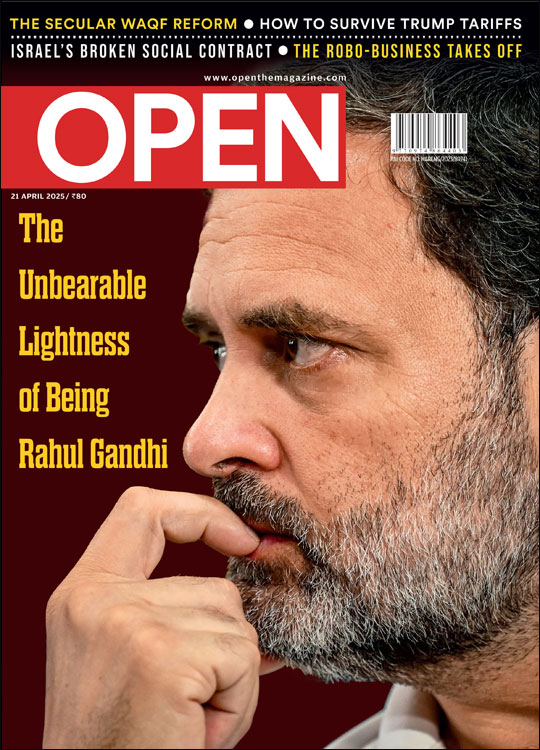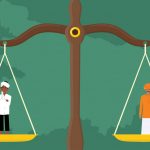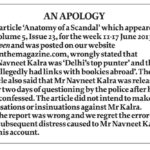Genetic Profiling: Is it all in the DNA?
A Bill seeks to make genetic profiling mandatory for the fight against crime—and generates a debate about the clash of ethics, freedom, science and data
/wp-content/uploads/2016/01/19298.isitallindna1.jpg)
When British geneticist Sir Alec Jeffreys first developed the DNA profiling test 31 years ago in his laboratory at Leicester University, he didn’t help the police prove a man guilty. His test—back then it took weeks to complete DNA profiling procedures as opposed to a few hours now—proved that a rape suspect in police custody was innocent. Details from the whole exercise also subsequently helped the local police nab the real criminal, who had killed his teenaged rape victim. Later, the police found that he was the one who had committed a similar crime three years earlier in a village nearby. Britain was destined to make great gains in solving crimes thanks to DNA identification, while the rest of the developed world, including the US, caught up later, but only after lagging initially thanks to the relentless—and sometimes ill-founded—opposition from civil liberties activists. In India, the Human DNA Profiling Bill, 2015, a proposed law that envisages collecting DNA finger prints—which are unique to an individual—especially of criminals, has been in the making for the past 12 years. The draft bill, which will shortly be placed before the Union Cabinet for its nod, has been prepared by the Department of Biotechnology and the Centre for DNA Fingerprinting & Diagnostics (CDFD), a Hyderabad-based Central Government-run agency, after examining and reviewing submissions by a panel of experts, holding consultations with various stakeholders and getting responses from the public. Notwithstanding the claims of safeguards against any misuse of the intended DNA data base, activists, lawyers, internet freedom fighters, civil liberty activists and columnists have been up in arms against the Government, arguing that the DNA profiling bill is ill- conceived and naïve—to the extent that it would destroy an individual’s right to privacy as it lacks provisions to check data tampering.
The international experience has proved otherwise. Ever since Sir Jeffreys extracted DNA from human muscle tissue, identified and processed genetic markers (which are unique to individuals except in the case of identical twins) from what was until then considered ‘seemingly purposeless segments of the human DNA’ in the words of writers Peter Reinharz and Howard Safir, more than 500,000 ‘otherwise unsolvable’ cases have been solved in the developed world thanks to the DNA identification, note CDFD scientists. DNA is the hereditary material in the human body. It is found in blood, saliva, urine, strands of hair, semen, tears, skin, etcetera.
Dr Madhusudan Reddy Nandineni, staff scientist and group leader, laboratory of DNA fingerprinting services and laboratory of genomics and profiling applications, CDFD, is worried that opposition to the Bill is gaining momentum in India due to a raft of reasons. Of course, the West, too, has witnessed sharp protests against DNA profiling laws. One of the key reasons anti-profiling activists have an edge, says a senior Home Ministry official who asks not to be named, is that there is a “general public anxiety” over “anything to do with disclosing personal details”. He agrees that the tests are going to be intrusive, because muscle tissue may have to be collected from private parts. The procedure of DNA sample collection—as explained in the draft Bill submitted in January by a committee headed by TS Rao, senior adviser to the department of biotechnology—talks about obtaining intimate body samples of living persons (on page 6-7 of the 48- page document) from ‘the genital or anal area, the buttocks and also breasts in the case of a female’. According to the draft Bill, it also involves external examination of private parts, taking samples from pubic hair or by swabs or washing or by vacuum suction, by scraping or by lifting by tape and taking of a photograph or video recording of, or an impression or cast of a wound in those areas. “But then, it is par for the course,” says the Home Ministry official by way of justification.
American military historian and author Edward Luttwak agrees that DNA profiling is a significant intrusion into the “very body of a citizen”. That is the price one has to pay in the choice between liberty and equality before investigation, he posits. Luttwak is glad that in the US, as well as in other countries that have such profiling laws, DNA identification has yielded results. “It protects suspicious/ low status but innocent people from false accusations and helps to catch clever/high-status law-breakers,” he says.
For his part, Dr Nandineni says that every aspect of the Human DNA Profiling Bill for India is based on similar legislation that has already been implemented in the US, Canada, UK, Australia and Continental Europe for more than 20 years. He also contends that the benefits that have accrued there are enormous, which India has missed out on for all these years. “In all these countries, the concerns of the general public on privacy matters have been allayed in their legislation,” he adds. He points out that the retention of DNA profiles in a ‘DNA Data Bank’ is meant to apprehend repeat offenders and thus serve a larger societal good. As regards privacy concerns, Dr Nandineni says that consultations on the preparations of the Bill lasted for 2-3 years and took into account the views of an expert committee whose members included representatives of NGOs.
Dr Nandineni is of the view that the opponents of the Bill have managed to get an upper hand in a national debate thanks to their media-savvy backgrounds. Agrees the Home Ministry official: “Perhaps the drafters of the Bill have not been communicative enough in getting their points across to the public and the media. Which might explain why the Bill has come under tremendous attack in the media. Even otherwise, global trends also show that civil liberty rights activists have had great initial advantage in their campaign against DNA profiling.” After all, the potential for misuse of DNA samples is not restricted to biological material collected under the provisions of the DNA Bill alone, Nandineni offers. “Any and every blood sample collected by a clinical laboratory has the same potential for misuse,” he says.
While Dr J Gowrishankar, director, CDFD, has been vocal about the positives of the Bill, its opponents have been louder. Many of those who oppose the Bill say the question is not one of being loud or feeble, but about being naïve or not.
The likes of Sunil Abraham, executive director of Bangalore-based internet research organisation Centre for Internet and Society (CIS), have no argument against DNA profiling being the gold standard for all forensic investigations. “There is nothing wrong with using DNA evidence for forensic purposes,” says Abraham, “However, the draft Bill is filled with techno-utopianism; it assumes that the people and machines that leverage DNA technologies are infallible.” He goes on, “This is not true. It is easier to tamper with DNA evidence than it is to tamper with a video recording. Therefore, all we are asking for are process checks that prevent compromised persons and machines from using DNA evidence to convict or exonerate the wrong person.” His contention is that if the DNA sample is sent to two different labs and both labs come back with exactly the same result, then the courts can be convinced of the veracity of the result. “Also the Bill says that DNA labs will give courts ‘yes’ or ‘no’ answers to questions related to DNA matching. But ideally, the lab must give the exact match percentage along with all the detailed information that emerges from the match process so that the court can fully appreciate the significance of the DNA evidence,” he suggests.
Abraham and legal scholar Usha Ramanathan—both members of the expert panel who filed notes of dissent and disagreed with various aspects of the Bill—have a problem with the claim that the proposed DNA data bank will cover only criminals and not the general public. Points out Ramanathan: “The Bill does not restrict the data base to criminals alone, not by a long shot. The provision in the proposed Bill reads: ‘(Clause 31(4)) Every DNA Data Bank shall maintain following indices for various categories of data, namely: (a) a crime scene index; (b) a suspects’ index; (c) an offenders’ index; (d) a missing persons’ index; (e) unknown deceased persons’ index; (f) a volunteers’ index; and (g) such other DNA indices as may be specified by regulations.’ That is an elaborate set of indices. There is certainly a lot of the ‘general public’ in it.”
Supporters of the DNA Profiling Bill have maintained that a DNA data bank is not for the public but only for a limited category of individuals. The proposed law also provides for storing profiles with the consent of relatives of missing children and grownups so that relationship identities can be established.
Ramanathan is also worried that apart from purposes of criminal justice, DNA profiling may be extended to parental disputes (maternity or paternity), issues related to pedigree, those related to assisted reproductive technologies (surrogacy, in vitro fertilisation or IVF, intrauterine implantation or IUI, and so on), to transplantation of human organs (donor and recipient) under the Transplantation of Human Organs Act, 1994, and also related to immigration or emigration. She had objected to the requirement of revealing a person’s caste in the application form for offering blood samples. “This Bill is certainly not a convict data base. The ambitions are much much vaster, and little to do with crime control,” she alleges.
Abraham agrees that some safeguards have been built in the proposed law to prevent any misuse of DNA data under pressure from expert panel members such as him. However, he says, cyber security and privacy-related issues are not addressed in a comprehensive manner. “The Bill basically hopes that the Privacy Bill will address all of this when it becomes law. But unfortunately, a bill could take 7-10 years before it becomes law,” he says.
Dr Gowrishankar of CDFD and others have conceded that it was the decision of the expert panel to include an enabling provision for the privacy issues of DNA profiling to comply with the proposed Privacy Bill.
Abraham says that various measures to prevent ‘privacy harms’ to volunteers are missing in the latest draft of the Bill. “Given that biometric technology works on probabilistic matching, the larger the size of the database, the larger the incidence of mistaken identification. Therefore it is important that the database remain as small as necessary,” he asserts.
The estimated cost of the Bill is Rs 20 crore—to create the infrastructure for the DNA Profiling Board and the data bank, which includes buildings, furniture, computer servers and so on. Among other things, the DNA Profiling Board is tasked with the responsibility of laying down and implementing standards for laboratories and proper protocols for ‘Data Bank’ operations.
CDFD scientists and government officials are keen to highlight the ‘under- hyped’ benefits of DNA profiling –similar to the Innocence Project in the US, which was aimed at securing the release of people who were erroneously convicted on the basis of other lines of evidence. Abraham has no patience for such comparisons. “DNA profiling for forensic purposes is very advanced and sophisticated, but technologies do not exist in a vacuum,” he says, “These advanced technologies have to work within traditional institutions with vulnerabilities and flaws. We need to, therefore, have non-technological procedural fixes that ensure that these technologies are not compromised by money and power. The choice is between the right to privacy and the rights and requirements of the criminal justice process.”
Ramanathan agrees with that view. “In the Indian context, the state of investigation is so poor that we have been looking for ways of circumventing our problems, not addressing them. That is how narco-analysis began to be used, till the court struck it down. DNA may be more reliable than most other scientific tools available to us today, but it is not all about the science. We also have to worry about contamination, what happens in the chain of custody, its potential for being planted or otherwise abused, and the errors even in the laboratory. You may remember the avowed mix-up of results in the Aarushi [Talwar murder] case, something the lab said they noticed over two years after they had given it to the investigators. The danger of treating DNA as conclusive and not needing corroboration is exacerbated in this kind of a vulnerable system. Which is why bringing this into a DNA data base law and not putting any checks on criminal procedure is less than wise,” she elaborates. She is least impressed with the ‘idea’ of ‘pedigree’ and of ‘population genetics’ in the Bill. “Institutions like the CDFD have been collecting DNA from suspects and asking for the caste of the person on the form. How does this seem innocent and safeguarded?” she asks.
Meanwhile, columnist and author Salil Tripathi says that it is sheer hubris to think that technology will provide all the answers to crime-fighting. “Tech- nology is enormously useful and powerful, but it is value-neutral; it can be used for good or bad ends… There have to be sufficient safeguards, overseen not only by technologists, law enforcement officers and bureaucrats, but also by lawyers and civil liberties experts, who can point out potential flaws and misuse and prevent those.”
Tripathi, too, is piqued that one of the markers sought is of caste. “Why?” he asks, emphatic that the country’s people should be concerned about allowing the state so much power over their lives. “And it may not be only the state; given that the scope of its future expansion is undefined, what guarantees are there that private actors won’t have access to the data, and if so, what security protocols would apply?”
Dr Gowrishankar and Dr Nandineni are right in saying that without DNA fingerprinting, many international criminals would still be at liberty, and the opponents of the Bill do not disagree with the efficacy of the technique developed by Sir Jeffreys. Instead, they are placing the spotlight on various objectionable aspects in the proposed law. In a country which first needs—according to former RAW chief Vikram Sood—to ensure access to Photofit (a technique to create an accurate image of a person that gels with a witness’ description) for its ground-level police operatives to combat crime, critics of the Bill seem to have won the war of words.
About The Author
CURRENT ISSUE
The Unbearable Lightness of Being Rahul Gandhi
MOst Popular
3

/wp-content/uploads/2025/04/Cover-Congress.jpg)













More Columns
The Numbers Game V Shoba
MS Dhoni’s investment in Gensol suffers a blow amid financial scandal Open
Dhankar takes on judiciary over ruling on President powers Open